Walter Chesnut UMASS Trumpet

Professor Walter “Wally” Chesnut UMASS-Amherst Trumpet Instructor circa 1970
Walter Chesnut UMASS Trumpet Instructor
1967-2001
Professor Walter “Wally” Chesnut (1936-2007) was the
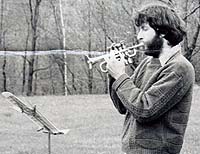
Author, Bob Amato UMASS-Amherst 1967-1972 practicing Selmer 4 piston valve piccolo trumpet outdoors in the fall of 1970.
second UMASS-Amherst Music Department Faculty Member that I ever met. The first UMASS-Amherst Music Department Faculty Member that I met was Professor John Jenkins who introduced Professor Chesnut to me during the Summer of 1967. Professor Walter “Wally” Chesnut was a member of the UMASS-Amherst Music Department from 1967 – 2001.
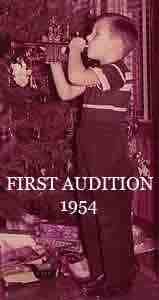
Bob Amato preparing for his first audition at the age of 5 on Christmas Day 1954
Although I knew that I wanted to be a professional Trumpet player from the age of 5 years old, my Mother was never thrilled with the idea of her only child making a living at a profession that brought tenuously few opportunities at the best of times. Consequently, I applied and received written notice that he was awarded admission to the UMASS-Amherst School of Electrical Engineering to begin in September 1967 when I was still 17 years old.
In the Spring of 1967, I played 1st Trumpet/1st Chair with the Berkshire All County Band. The Celebrity Guest Conductor for this event was Professor John Jenkins. Professor Jenkins was the Director of the UMASS Bands Program and was a close personal friend of Professor Chesnut’s. Professor Jenkins encouraged me to meet with Professor Chesnut and then consider changing my Major at UMASS from Electrical Engineering to Music.
During the later part of the summer of 1967, my parents drove me to Amherst to meet for the first time with Professor Chesnut. At the meeting/audition, I performed excerpts from the Arban’s version of Carnival of Venice. This was same ‘audition number’ that I used to audition for the Berkshire All County Band and the only classically oriented trumpet solo that I had ever practiced up to that time frame.
The only thing about this initial performance that Professor Wally seemed to be impressed with was my ability to single, double, and triple tongue rapidly with relative ease.
I told Professor Wally that I had ‘learned on my own’ at the age of 14 years a seldom used, but highly efficient method of tonguing. This method of tonguing is referred to as ‘K-Tonguing’ and also ‘Anchor Tonguing’ and ‘Dorsal Tonguing. This tonguing method technique was famously
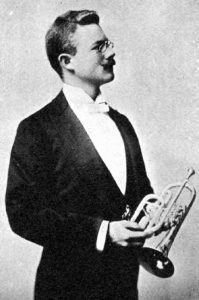
Herbert L. Clarke Holding His Cornet circa early 1890’s.
employed (but soon forgotten) and taught by turn of the 20th Century, Cornet Virtuoso Herbert L. Clarke (1867-1945). Clarke provided a detailed written explanation of this method in Clarke’s book entitled ‘Elementary Studies’ (also see – Characteristic Studies where Clarke describes his tonguing method:
“My tongue is never rigid when playing, and rests at the bottom of my mouth, the end pressed slightly against the lower teeth. I then produce the staccato, by the center of the tongue striking against the roof of the mouth. This I have practiced so as to acquire a rapid single tonguing without fatigue, nor causing a clumsy tone, and when under full control, Double and Triple Tonguing become a simple matter by diligent practice, keeping the mind upon each articulation. To produce a sforzando attack, such as in Trumpet playing, the point of the tongue is used decisively. In my Elementary Studies, First Series, I state that there is no set rule for cornet playing, except by playing naturally; consequently there is no set rule for tonguing. Each player must discover the most natural and easiest way for himself. There is any amount of experimenting necessary, before one really feels the proper way. Use of the syllable “Tu,” not “Thu” in the middle register, seems to be the most natural way to express the attack.”
By the 1960’s very few trumpet players used this method of tonguing and the ones that did were most notably:
- Armando Ghitalla Principal Trumpet Boston Symphony who also taught this method to his students
- Claude Gordon – Noted Hollywood Movie Studio lead trumpet recording session player and teacher. Herbert L. Clarke personally taught this method of tonguing to Gordon.
- Doc Severinsen – Renowned extraordinary commercial trumpet soloist and band leader.
Bob told Professor Chesnut that Bob started playing lead trumpet in Joe Salerno’s 12 piece dance band when he was 14 years old. Bob added that the 2nd Trumpet player was an older trumpet player, Pete Demeo who played Harry James type of solo’s in various Army Dance Band’s during WWII and Pete let Bob borrow his copy of Clarke’s book. Pete did not use this method of tonguing, but suggested that Bob give it a try.
Bob told Professor Chesnut that this type of resting tongue placement must be used during the course of simple ‘whistling’. And, Bob has been a chronic ‘under his breath’ nervous whistler from his youngest days. This method of tonguing was second nature to Bob and was easy for Bob to implement.
Professor Chesnut also told Bob that Professor Chesnut was familiar with this method of tonguing, but Bob was the first trumpet player that Professor Chesnut ever met that could actually tongue in this manner.
Professor Chesnut urged Bob to never change using this method of tonguing.
After Professor Chesnut discussed Bob’s method of tonguing with Bob, Professor Chesnut picked up his own B Flat trumpet and from memory began to play some of the same excerpts from the Arban version of Carnival of Venice that Bob performed.
Bob was awestruck! Professor Chesnut was at that point, by far the finest classical trumpet player that Bob had ever heard in person. Professor Chesnut produced a tone quality that was gorgeous, with a rich symphonic sonority. Professor Chesnut’s articulation was perfectly precise and intonation was perfect. And, above all Professor Chesnut performed with great ‘musicality’ with beautifully crafted phrasing. That initial Professor Chesnut performance was memorable and notably uplifting.

Punch of ‘Punch and Judy’ character whose head is reminiscent of the cloth hand puppet that Professor Walter Chesnut would place over the forefinger of his right hand while playing the Carnival of Venice on trumpet with one finger managing the valves.
(After Bob enrolled at UMASS-Amherst in September of 1967, Bob learned that Professor Chesnut had performed the Arban’s version of the Carnival of Venice publically on countless occasions during the course of demonstrations and music clinics. In fact, when Professor Chesnut performed the Carnival of Venice in front of a group of young, grammar school aged children, he would wear a special glove fashioned like a Punch and Judy puppet character named Punch. Professor Chesnut would play some of the very fast parts of Carnival of Venice with one finger instead of three. The head of the puppet would be fixed to Professor Chesnut’s forefinger and would rapidly bob up and down through the fast paced passages of the composition. The effect was hilarious to behold and all the children would laugh and applaud with glee during the entire puppet aided performance. Professor Chesnut had a very expressive way of demonstrating his musical skills coupled with a charismatic personality. Young children in particular loved everything about Professor Chesnut’s extremely capable musical demonstrations on trumpet. Professor Chesnut would enjoy these humorous performances every bit as much as the children in the audience. It is a shame that it is unlikely that none of these Walter Chesnut ‘hand puppet’ enhanced versions of these masterful childrens oriented performances of Arban’s Carnival of Venice are preserved on video tape.)
After ‘showing off’ for a couple of minutes, Professor Chesnut played short excerpts of the Carnival of Venice and stopped. Professor Chesnut asked Bob to play the same excerpt that Professor Chesnut just completed and try to match the phrasing. The Professor Chesnut demonstrations of each excerpt would get slower and slower until Bob could find a pace that would demonstrate an improved delivery of Bob’s rendition of the excerpt.
Initially Bob was quite embarrassed and really was at a complete loss. Although Bob’s band director in Adams, Massachusetts Joe Salerno was a trumpet player, Mr. Salerno had no where near the playing and teaching skills that Professor Chesnut had. But, after repeated stop and starting, most importantly listening to Professor “Wally” over and over and over again, in about an hour, Bob finally began to show some improvement in performing some of the Carnival of Venice excerpts.
Both of Bob’s parents were every bit as impressed with Professor Chesnut as Bob was. By the time that Bob arrived home back in Adams, Massachusetts 75 minutes, Bob’s Mother agreed to allow Bob to change Major’s from Electrical Engineering to Music. Bob wrote a letter to Professor Chesnut the next day informing him of the change of major. Professor Chesnut mailed to Bob a nice letter in response and suggested to Bob that Bob pursue a
Bachelors Degree in Trumpet Performance and a second Bachelors Degree in Music Education.
Walter Chesnut’s Trumpet Teaching Studio
In 1967, the Undergraduate and Graduate student enrollment at UMASS-Amherst had grown to well over 30,000. This unprecedented rapid growth in student enrollment was caused by two factors. The first factor was the huge spike in the United States population that began in 1946 caused by the end of WWII and the return of millions of Servicemen to their homes. The second factor was the GI Bill which provided substantial financial incentives for United States Military Veterans to acquire a College Education. By 1965, an enormous number of young American men were drafted and/or enlisted to serve during in the military during the Vietnam War debacle period. In the Navy, Air Force, and Army, the minimum time that one could serve to earn Military benefits upon discharge was two years. By 1967, a large number of men in their early 20’s who served in Vietnam that were qualified academically to attend UMASS-Amherst did so under educational provisions established by way of the GI Bill.
This enormous influx of new students caused UMASS-Amherst to embark on an enormous number of massive construction projects that would provide dormitory housing, cafeteria’s, and classroom facilities for the burgeoning student body. And, new office’s needed to be constructed to accommodate the growing faculty and administrative staff as well.

This is an example of a single wide construction site mobile home that was provided to at least six UMASS-Amherst faculty members from at least 1966-1972. Each of these temporary trailer’s were partitioned to provide two classroom teaching spaces of around 160 square feet.
Beginning around 1966, at least for the growing UMASS-Amherst Music Faculty, temporary, construction site, mobile home trailer’s were used to provide office, teaching studio, and classroom accommodations for some of the newer UMASS faculty members. These mobile home trailers were ‘single wide’ and were of the same ‘low rent’ construction quality that are commonly seen to this day at construction sites all over the United States. The trailers were partitioned in one half. Each half of the trailer provided classroom and teaching space for one Music Faculty member. Each classroom space was provided with a small half bath that included a lavatory and commode.
These construction site quality office trailers were probably 10 feet wide and 32 feet long.
If this was the case, each trailer provided two teaching facilities that were 160 square feet.
And, these temporary classrooms were very poorly insulated. No sound deadening provisions were provided for. Whatever music class was assigned to the room partition that adjoined Professor Chesnut’s teaching studio must have suffered through an enormous volume of not always pleasant to listen to sound that must have been enormously distracting.
At least three trailers were established for the Music Faculty and were placed adjacent to a large vehicle parking lot that was centrally located on the UMASS-Amherst campus.
The Music Faculty trailers had their own newly constructed driveway access that was never paved and would become quite muddy when it rained and during the entirety of the winter months. The steps to get into each of the trailer classroom partitions were unpainted steel frames that provided 3 very rusty and very uneven steps to gain access to the ‘temporary’ teaching facilities.
These temporary facilities were conveniently located and were less than a 200 yard walk from the Old Chapel rehearsal and practice facility, other permanent Music Department music buildings, and the outdoor Fall seasonal practice field for the UMASS-Minuteman Marching Band.
Professor Walter Chesnut was assigned to one of these three mobile home trailer classroom facilities that provided teaching facilities for at least six Music Department Faculty Members.
However, these ‘temporary’ Music Department facilities proved to be of a more permanent nature. These mobile home trailer teaching facilities were used continuously by the original UMASS Faculty occupants from 1966 through at least 1972.
When Bob arrived at UMASS for formal enrollment in September of 1967, Bob discovered that the number of credits needed to get both a Bachelors Degree in Trumpet Peformance and a second Bachelors Degree in Music Education would involve at least 135 credit hours and possibly much more, Bob decided to spread his studies over a 5 year period. In the 1967-1972, the cost of tuition at UMASS-Amherst was $100 per semester. Bob had saved
up money since the age of 14 years of age performing very actively year round through his high school years with two different dance bands. The cost of going to UMASS-Amherst for five years was not going to be a factor.
When Bob arrived at UMASS-Amherst in September of 1967 there were a lot trumpet

Professor Walter Chesnut UMASS-Amherst Trumpet Instructor with Music Department Brass Trio Members John Jenkins on French Horn and Larry Weed on Trombone circa 1968.
players ‘running around’ campus that were scheduled to take private trumpet lessons with Professor Chesnut. There must have been at least 30 trumpet players scheduled to take private lessons from Professor Chesnut. The private lessons lasted about 50 minutes or so. There were some non-music major trumpet players who took private lessons with Professor Chesnut. The majority of the trumpet students were Music Education majors.
Other than Bob, there was only one Trumpet Performance Music Major, the extremely talented, Douglas Purcell [’69]. Doug also continued on to earn a Masters in Music Education from UMASS which Doug wrapped up in the early 1970’s. Another Trumpet player, but Music Education major, Jerry Mirliani [’69] was also excellent. From 1967-1969, Doug and Jerry played 1st and 2nd chair next to each other in both the Symphony Band and University Symphony Orchestra. Bob was elevated to 1st chair in both Symphony Band and University Symphony when Doug go his BA in 1969. Doug and Jerry were by far the music major trumpet players that Bob met at UMASS from 1967-1972. The two best non-music major trumpet players that Bob performed with from 1968-1972 were Sylvia Gaviglio and John Perko who were both excellent although not up to either Doug’s or Jerry’s overall more advanced capabilities.
In addition to a full daily schedule of conducting private lessons, Professor Chesnut conducted at least two weekly ‘Applied Trumpet Music Education’ classes for the benefit of non-trumpet Instrumental Music Majors who had ambitions in teaching in a public or private school system. Professor Chesnut schedule was so full that it was common for him to begin teaching at 7AM on a Monday through Friday basis that continued without even a lunch break into the late afternoon hours.
And, Professor Chesnut taught private lessons from around 8AM to Noon each and every Saturday as well. Between 1967-1972, Professor Chesnut taught trumpet at least 60 hours a week. Plus, Professor Chesnut performed Principal Trumpet with the Springfield, Massachusetts Symphony, performed routinely on Music Faculty Recital programs and attended all his trumpet students recitals.
The drop off in trumpet playing skills of the players who were less capable than Doug Purcell and Jerry Mirliani in September of 1967 was considerable. At best Bob’s trumpet playing skills would be ranked in the middle of this rather deplorable lot of optimistic budding talent.
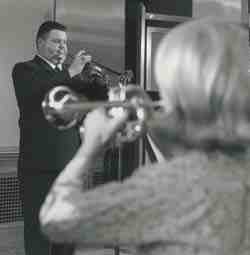
Walter Chesnut teaching an ‘Applied Trumpet Class’ to instrumental music education majors who did not play trumpet. Circa 1968
Other than ability tongue well and sight read to a pretty fair degree, Bob’s trumpet playing skills were quite rough around all audible edges.
Here are the 12 areas that Bob had to really work on to improve his performance abilities:
1. Embouchure – Bob tended to routinely puff his cheeks when he played the trumpet. The expansion of the cheek muscles was not anywhere as extreme as ‘Dizzy Gillespie’, but it was a matter that
needed to be addressed. Professor Chesnut directed Bob to practice long tones of very long duration and slow perform scales and arpeggios over a period of a number of months to correct excessive ‘cheek puffing’.
2. Precise Timing and meter – Bob’s sense of musical time and meter was initially very imprecise. Bob had a notable tendency to rush the meter when either playing fast moving musical passages or ascending the musical scale. This problem was managed by the proper use of a metronome when practicing.
3. Production of a high quality tone – Professor Chesnut prescribed to Bob countless hours of performing long tones – 8 to 30 seconds in duration or more of every note on all playing registers performed at pianissimo to forte fortissimo volume levels. Repeatedly, Professor Chesnut reminded Bob to completely focus on developing a clear, well centered, pleasing to the ear tone quality.
4. Breath Control – When Bob started trumpet lessons with Professor Chesnut he did not implement nor understand the concept of ‘deep diaphragm’ breathing. Bob implemented ‘shallow chest only breathing’
that only filled a small portion of the lungs. This skill was magnified by some simple deep breathing exercises that trumpet player Jerry Mirliani routinely utilized and passed on to Bob. Jerry could project an enormous volume of sound in all registers including
way above High C on the trumpet that was still pleasing to the ear. In his prime, Bob was also able to match and probably well surpass Jerry’s ability to project a trumpet sound that could be heard in at least ‘3 States’. Bob’s breath control became so refined that
Bob could hold a middle staff C at moderate constant volume for almost 1 1/2 minutes without taking a breath.
5. Mastery of Basic Fundamental Trumpet Playing Skills – Professor Chesnut started Bob with Arban’s Complete Conservatory Method for Trumpet from the very beginning. Professor Chesnut had Bob perform each and every Arban exercise over and over for at least a year to year and a half until Bob could perform each of the many Arban exercises flawlessly.
Over and over, Professor Chesnut emphasized ‘Critical Listening’ skills. Bob was directed to very carefully to listen to recordings of classical trumpet players with advanced skills as well as classical music performers who perform other musical instruments to a high proficiency.
Professor Chesnut gave Bob’s trumpet lessons his complete undivided attention. If Professor Chesnut detected a flaw in Bob’s performance of an exercise that Professor Chesnut assigned to Bob, Professor Chesnut would play the exercise in the proper manner. Bob would be instructed to repeat what Bob heard Professor Chesnut perform. If Bob, made a mistake, Bob would play the exercise slower and slower until the exercise could be played correctly at a slow speed.
After Professor Chesnut felt that Bob had mastered the Arban’s Complete Conservatory Method for Trumpet, Professor Chesnut moved Bob to Herbert L. Clarke’s Technical Studies. Professor Chesnut’s approach to perfecting the performance of these exercises was the same he directed Bob to use with Arban’s. And, Bob used the Herbert L. Clarke Technical Studies as a part of warmup and maintenance of existing skills for his entire playing career. Professor Chesnut also had Bob work through Schlossberg’s Daily Drills, Clifford Lillya’s Trumpet Technic as well as Walter Smith’s Lip Flexibilities.
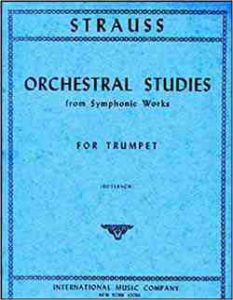
Richard Strauss – Orchestral Studies for Trumpet
6. Introduction of Symphonic and Chamber Music Literature. Professor Chesnut introduced Bob to the Symphony as well as Chamber Orchestra musical compositions that featured the trumpet in a significant manner. By 1974, Bob had committed to memory the most important 1st trumpet and or 1st trumpet solo parts for almost 200 ‘main stream’ orchestral and chamber music repertoire. And, by 1974 after many years of practice, Bob could perform any or all of these hundreds and hundreds of musical excerpts individually or in a totality upon request with hardly ever a missed note. Between 1967 and 1974 Bob had acquired and practiced through all of at least 20 or more different volumes of Trumpet Orchestral Excerpt Studies published by the International Music Company. Plus, numerous other Orchestral Trumpet excerpt exercise studies as well.
7. Introduction to classical trumpet solo repertoire. Professor Chesnut introduced
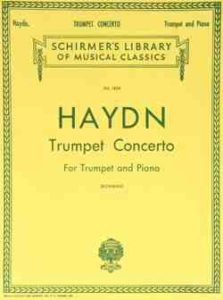
Haydn Trumpet Concerto
Bob to over 40 ‘main stream’ classical trumpet solo’s. Bob performed at least 25 of these solo’s at student recital, orchestral performances or church performances accompanied by Organ between 1967-1972.
8. Introduction to Brass Chamber Music. Professor Chesnut introduced Bob to the vast world of Brass Chamber Music. By 1972, Bob’s personal brass ensemble library exceeded well over 200 selections that ranged from Brass trios, quartets, quintets in particular, sextets, septets, and antiphonal brass choir musical selections. The entire library was purchased either by mail order or in person from Robert King Music Sales in North Easton, Massachusetts. By 1972, Bob’s personal brass ensemble library was far, far larger than the brass ensemble library
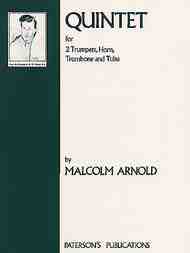
Malcolm Arnold Brass Quintet
on file at the Umass Music Department Library. And, with Professor Chesnut’s able teaching, Bob could capably perform all of the 1st trumpet parts of this large library. Bob performed many of the selections from this library with various music major brass students at UMASS-Amherst.
9. Sight Reading and Key Transposition. Professor Chesnut directed Bob to practice a trumpet exercise book by Robert Nagle which might have been called ‘Speed Skills’ which provided advanced sight reading exercises. For key transposition practice, Professor Chesnut had Bob go through the Sachse Studies. Bob also recalls some mention and probable use of Earnest Williams Method of Transposition as well by Professor Chesnut.
10. Precision Pointillistic Attack. Too provide absolute precise ‘attack’ with pauses between extremes of registers and at different volume levels – ‘pointillism drills’ were employed by Professor Chesnut. Professor Chesnut directed Bob to purchase another Robert Nagle book of exercises that Bob cannot remember that was specific to ‘pointillism drills’ Bob covered from start to finish. Additionally, Professor Chesnut would sometimes ask Bob to write down his own random ‘pointillism drills’ on a blank sheet of music paper. A series of random quarter notes or eighth notes over spread over one or more octaves between each note. The volume of attack on each note would very randomly between extremely loud and extremely soft. This is a very difficult drill to get used to, but over time it gets much easier and improves a trumpet players control over pitch, volume, and accuracy to a substantial degree.
11. Intonation – Learning How to Play in Tune with other Musical Instruments. – It does not take ‘Perfect Pitch’ to be able to consistently play in tune with other musical instruments. Playing in tune requires an understanding on how to develop reasonably advanced Relative Pitch skills which enable the musician to hear even the slightest variations in pitch with regarding to playing in tune with other musical instruments. Professor Chesnut introduced to Bob a simple to understand and repeatable method to hearing even the smallest variations in pitch.
This is how Professor Chesnut taught a trumpet player to play in tune with other musical instruments:
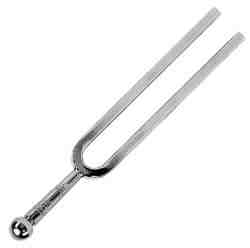
A440 – Tuning Fork
Professor Chesnut would strike a tuning fork tuned to ‘A 440’. Professor Chesnut would then immediately play his own ‘A 440’ in the trumpet which would initially match and sound to the identical vibratory frequency as the tuning fork. Before Professor Chesnut would play the matching ‘A 440’ frequency on his trumpet, he would tell Bob that he would then modulate his own pitch to a minor degree either ‘sharp or flat’ to perfect ‘A 440‘. Bob was instructed to verbally tell Professor Chesnut if Professor Chesnut was playing either sharp or flat to that ‘A 440’.
The next step would be for Bob to play ‘A 440’ on his own trumpet in concert with the ‘A 440’ tuning fork. Professor Chesnut would rather quickly train Bob to detect and hear small variations in his tone production that were either sharp or flat to ‘A 440’. Over time, even the smallest variations in pitch would create slow moving pulseations that became easy for Bob to detect.
The final step would be for Professor Chesnut to play random long tones on his own trumpet. Bob would then play the same tone until the pitch on Bob’s trumpet would perfectly match the pitch that Professor Chesnut’s trumpet was producing. If the variation in pitch was slightly too much, Bob would adjust the tuning slide on his own trumpet to a very small degree.
12. Learn how to play the trumpet in a musically expressive and pleasing manner. Learning how to play musically is a very subjective skill that even the most technically skilled professional musicians can find themselves at least somewhat lacking.
The development of a beautiful tone that is pleasing to the ear is a huge asset. However, how does that beautiful tone transfer to performing a musical phrase with such subtle nuance and ‘soulfulness’ that sets the player off from their other highly regarded peers. CRITICAL LISTENING! The musicians whose musical phrasing is consistently the most beautiful and uplifting to listen to have trained their ears to tap deeply into their own ‘souls’ most heartfelt response to a given musical phrase. If a trumpet player listens to the musical phrasing of trumpet players such as Maurice Andre’ or Timofei Dokshizer recordings long enough and carefully enough, at least some of those master trumpet players musical phrasing will at least embed itself within the ears of a student trumpet player.
A very simple test of a trumpet players ability to play a musical phrase in a manner that is most pleasing to the ear, is to have the trumpet player play a very simple melody. Most trumpet players know how to play ‘Taps’ from performing this simple melody without the use of valves at military oriented funerals and ceremonies. Another somewhat more
complex simple melody is the performance of the ‘Star Spangled Melody’. Even amongst highly skilled trumpet players, the variations in the quality of the musical interpretation will be endless. But, unless a trumpet player can play Taps and the Star Spangled Banner as well as ‘Susan Slaughter’, that trumpet player needs to figure out a way to play in a more musical manner.
So how does a musician learn to play with ’emotion’? Professor Wally Chesnut initially told Bob in September of 1967 to ‘sing the melody or musical’ phrase though the trumpet’. Early on, Professor Chesnut would encourage Bob to ‘SING’ while he was playing the trumpet. After hearing Professor Wally say ‘SING’ to Bob a few times, Bob actually began to have a panic attack. This is the verbal exchange between Professor Wally and Bob in the Fall of 1967:
Bob: Professor Chesnut, I am sorry to tell you this. I can’t sing!
Professor Wally: What do you mean you can’t sing.
Bob: I am afraid to sing.
Professor Wally: I have no idea what you are talking about. Please explain.
Bob: My first grade teacher was Mrs. Holleran. Mrs. Holleran decided to have all of the kids in the class sing a Children’s song. At first it was a lot of fun, but I got bored real quick with the way the class was singing the song. My Mother introduced me to the Music of Louis Armstrong by way of old 78 records before I could even walked. Before I was five years old, I knew the melodies to a lot of Armstrong’s Dixieland recordings. And, I loved the way Louis Armstrong sang a tune, and in particular how he would break into ‘skat singing’ jazz style improvisational vocal style. While the other kids were singing I started wailing Louis Armstrong inspired ‘skat style’ vocals which continued after the other kids stopped. Mrs. Holleran was mortified and very angry. She through me out of the class and locked me in the ‘cloak room’ by myself for a full hour. I never was allowed to sing ever again with the rest of the 1st grade class. And, I never sang again publicly in any capacity ever since then either. (AND, THIS TRAUMATIC INCIDENT ACTUALLY DID HAPPEN TO POOR YOUNG BOB!)
Professor Wally was incredulous. Professor Wally possessed an extremely sensitive

Pro Wrestler and Actor “The Rock” impersonating Professor Wally Chesnut’s raised eyebrow facial expression that was frequently directed towards his trumpet Student, Bob Amato
persona and his facial expressions were always incredibly expressive. Professor Wally’s facial expression were always animated and never a bit stoic. When Professor Wally heard something from Bob that Professor Wally thought was rather unusual or perplexing, Professor Wally would sometimes cock his head to the side and raise one eyebrow in the manner that some stage actors will do.
Professor Wally: You can carry a tune ‘INSIDE YOUR HEAD’ can’t you?
Bob: Of course, I am a chronic under my breadth whistler as well.
Wally: I assure you that I will never ask you to actually sing in front of me. Just sing what you are hearing inside your head through your trumpet and you will do just fine!
In addition to having Bob perform numerous Orchestral Excerpts, Brass Ensemble Literature, and Solo Trumpet literature in particular as musically as possible, Professor Chesnut assigned ‘Etudes’ to master from
the following publications:
- Marcel Bitsch
- Oscar Boehme Melodic Studies
- Bousquet – Celebrated Studies for Cornet
- Herbert L. Clarke – Characteristic Studies – Vintage Cornet Solo’s – “Maid of the Mist” and “Sounds Over the Hudson in particular.”
- Alexandre Petit – Etudes and Exercises.
- Concone – Various Lyrical Studies which were excellent
On his own, Bob went through Claude Gordon’s Systematic Approach to Daily Practice although Bob could never perform the exercises that extended way beyond High C with only but a modest degree of consistency and some never at all. However, Bob did well on his own with Charles Colin’s Advanced Lip Flexibilities.
When both older trumpet players Doug Purcell and Jerry Mirliani graduated in 1969, Bob was elevated to perform 1st Chair Cornet in the UMASS Symphony Band and 1st Chair Trumpet with the UMASS Symphony Orchestra.
Between 1967 and 1972 Bob practiced the trumpet 7 days a week year round even if he had a cold. And, the practice hours were not impacted by scheduled Band or Orchestra Rehearsals or paid gigs that Bob performed on weekends with Soul or Rock bands. The only time that Bob cut back on practice time was immediately before a student recital or a particularly demanding concert performance.
During College years on a Monday through Friday basis, Bob routinely practiced 2-4 hours a day. On weekends and over the summer months, Bob practiced 3-6 hours a day.
Each practice period generally lasted 60-90 minutes maximum with short breaks between each exercise.
Practice that involved extended upper register play required longer and more frequent periods of rest.
Between 1967 and 1972, Bob neither missed a lesson or was ever late for a lesson with Professor Walter Chesnut.
Professor Chesnut routinely assigned to Bob on a weekly basis more new materials than Bob could practice and adequately prepare to perform for Professor Chesnut at the next scheduled weekly lesson. Upon arrival at the next weekly lesson, Bob would tell Professor Chesnut what materials were prepared for review and Professor Chesnut would move on from there.
A major factor which made Walter Chesnut an excellent trumpet teacher was his boundless enthusiasm for all matters that revolved around the masterful performance of the classically oriented trumpet.
Walter Chesnut’s Method of Teaching
The following is a random summary of Professor Walter “Wally” Chesnut’s most important directions:
- Emulate Professor Chesnut’s own face to face, one on one trumpet playing demonstrations of exercises, etudes, and performance literature.
- Listen carefully to recorded performances of accomplished classical trumpet players and emulate those trumpeters tone quality and musical phrasing.
- Hear the very center of each and every note before attacking the note
- Use the syllable, ‘TE-TE-TE etc. when performing legato passages that required tonguing.
- Sing through the trumpet.
- To help relieve stiffness and fatigue from the lips, ‘putter the lips’ like a horse would ‘putter’. This action will immediately add additional revitalizing blood flow and oxygen to the lips.
- To help achieve a more centered tone, practice buzzing tones in various registers with the mouthpiece only.
- When practicing Etudes or performance musical literature, spend the bulk of the time practicing the most difficult passages.
- Initially practice difficult passages at a speed slow enough so that the entire difficult passage can be performed without any missed notes. Gradually speed up the execution of difficult passages until full speed is reached.
- Use a tuning fork and/or an electronic tuning box to develop relative pitch well enough to detect tuning discrepancies in one’s playing.
- ENDURANCE TRAINING! The trumpet by far the most physically challenging brass instrument. And, almost all trumpet players of all skill levels reach a point during performance that the embouchure – the lip muscles’ and particular become so fatigued and stressed out that a quality musical performance is difficult to achieve. Playing a challenging classical trumpet solo from start to finish without embouchure fatigue causing the performance level to break down takes a lot of work to remedy. After Bob could move a challenging classical trumpet solo from start to finish with reasonable aplomb, Professor Chesnut would direct Bob to immediately perform the same trumpet solo once again. Professor Chesnut told Bob if Bob could develop the ability to play a challenging trumpet solo two times back to back without resting without breaking down, the risk of breaking down after a single performance during a student recital would be eliminated. Within three years, Bob’s endurance increased to the point that Bob could perform all assigned challenging trumpet solo’s and brass ensemble literature that were prepared for student recital purposes, a full three times back to back without resting between performances. This type of endurance training paid major dividends when between 1977 and 1981 when Bob played lead trumpet with Ringling Brothers and Barnum & Bailey Circus. Bob was required to play Higher, Louder, and Faster for six to nine hours a day six days a week for endless months on end.
- Use a metronome diligently when practicing
- When practicing exercises, Etudes, or performance literature, always focus on producing the best tone quality possible.
- Learn to hear the desired result inside your head before you attempt to play a passage of any length.
- If at all possible, try to practice to some degree on a daily basis. The frequent repetition of will eventually eliminate performance inconsistencies and will help ensure more dependable results. Your body will make a habit out of the most efficient way that your body will find to achieve the end result.
- Enable a steady, relaxed, but focused airflow that will produce a rich, resonant tone on every note from the very first note.
- Professor Chesnut would sometimes refer to tone quality as ‘Breath of Sound’. The more pleasing the ‘Breath of Sound’ will indicate that the tone quality is focused to generate as many ‘over tones’ as possible within the ‘Breath of Sound’.
- Warm-up in the middle register at low to moderate volume levels, and gradually expand the range by alternating to gradually higher and then lower notes on the scale. Back and forth – higher and lower on the scale.
- Within your mind, imagine a beautiful tone or sound at all times. Remain completely focused on the quality of sound.
- At all times remember to imagine a beautiful sound. Keep your attention on that sound.
- Keep a rock steady air flow through the sound at all times.
- Remain mentally focused on the integrity of the sound.
- When practicing, try to relax as much as possible and avoid getting tense or anxious no matter how bad things appear to be starting out. By continuing to practice when one is tense or anxious on a habitual basis, will cause one to become tense and anxious while performing in front of an audience.
- Avoid holding the trumpet too tightly.
- Play it Straight! Never add ‘personal embellishments’ to a classical trumpet
 solo or orchestral composition unless it was a cadenza directed by the composer. NEVER JAZZ UP A CLASSICAL MUSICAL PERFORMANCE! The violation of this Professor Chesnut Commandment would be one of the very few ways to cause Professor Chesnut to become angry.
solo or orchestral composition unless it was a cadenza directed by the composer. NEVER JAZZ UP A CLASSICAL MUSICAL PERFORMANCE! The violation of this Professor Chesnut Commandment would be one of the very few ways to cause Professor Chesnut to become angry. - To help achieve control over the movement of air through the mouthpiece, practice long tones in all registers. Start the long tone at the softest piano pianissimo sound volume that is possible. Then, gradually increase the sound volume to as great a thunderous forte fortissimo sound volume that can be produced without ‘cracking the sound’. And, then without taking an additional breath, reduce the sound volume back down to the softest piano pianissimo sound volume that is possible.
- To achieve precise valve action, one should always press each valve quite firmly to the point of almost hammering the valves with the finger tips. The vigorous depression of the valves in a timely manner will reduce accuracy issues in attack and in timing in general.
- Avoid constricting or tightening the throat muscles while expelling air through the mouthpiece. Begin a daily warm-up by opening the mouth completely and expelling air by saying ‘AH and then OH’.
- MASTER THE ART OF DEEP DIAPHRAGM BREATHING! AND, AVOID LIFTING SHOULDERS WHEN INHALING A BREATH!
Walter Chesnut’s Musical Background

Clifford Lillya, University of Michigan Trumpet instructor circa 1950’s
In the late 1950’s Professor Chesnut earned a Bachelors and Masters in Music Education at the University of Michigan in Ann Arbor. The University of Michigan had then and to o this day has a classical music studies program that rivals the finast conservatories in the United States including Julliard, New England Conservatory and Eastman School of Music. Until 1979, the trumpet teacher at the University of Michigan at Ann Arbor was the renowned Clifford Lillya. In the 1950’s Clifford Lillya produced a boat load of exceptional classical trumpet players. Although Professor Chesnut was a Music Education major, Professor Chesnut was a top tier Clifford Lillya student.
Professor Chesnut was such a fine trumpet player that he was selected to perform featured cornet solo’s with the finest Symphony Band in the United States at the University of Michigan under the direction of the world renowned Director, Dr. William Revelli.
In Professor Chesnut college graduation class, the only trumpet player whose skills exceeded Walter Chesnut’s was Don Tison. Don Tison went on to play principal trumpet for many decades with the Baltimore Symphony Orchestra. Don Tison was Walter Chesnut’s roommate at the University of Michigan in Ann Arbor. Don Tison’s trumpet playing skills were beyond extraordinary and Bob had the good fortune to take
weekly private lessons with Don Tison in 1973-1974.
Without a doubt, the trumpet teaching methods that Professor Chesnut embraced at UMASS were passed onto Professor Chesnut by his own fine teacher, Clifford Lillya.
However, what really made Professor Chesnut special was his outgoing personality and ebullient spirit.
Bob had weekly lessons with Professor Chesnut for 10 full College semesters and each lesson was something to look forward and would become the highlight of each week without fail.
Walter Chesnut Only Enjoyed Classical Music
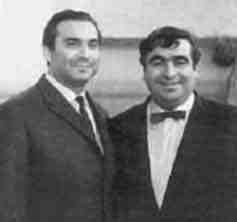
The phenomenal classical trumpet soloists Timofei Dokshizer (left) and Maurice André standing together circa mid to late 1960’s
Professor Walter Chesnut only enjoyed listening to, talking about, or performing classical music.
Between 1967 and 1972, Bob never heard Professor Chesnut listen to any recording including on the radio that did involve classical music. Almost all of the music that listened to was heavily focused on classical trumpet performance.
Professor Chesnut had absolutely no interest whatsoever in either Jazz or Popular Music of any type.
Beginning in September of 1967, Bob played lead trumpet at Sunday morning rehearsals of the Amherst Jazz Orchestra. Between 1967 and 1969 Bob played lead trumpet with the Forever Fabulous Incorporated Soul band. Professor Chesnut was aware of Bob’s activities with these organizations and never objected at least verbally to Bob.
However, Professor Chesnut made it clear that he did not teach ‘Screech Trumpet Players’. This form of trumpet playing became popularized by the high note playing of Cat Anderson with the Duke Ellington Orchestra, Maynard Ferguson as well as the arrangements of the Stan Kenton Orchestra, and other big jazz bands led by Woody Herman and Buddy Rich.
Professor Chesnut only taught trumpet players to perform in a much more refined classical musical manner.
With regards to classical trumpet soloist role models that Professor Chesnut encouraged his students to listen to were:
With regards to classical trumpet player role models that performed with Symphony
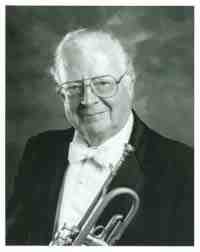
Adolph “Bud” Herseth (Principal Trumpet Chicago Symphony 1948-2001) was Professor Walter Chesnut’s favorite orchestral trumpet player.
Orchestras, Professor Chesnut encouraged his students to listen to were:
- Adolph “Bud” Herseth – Principal Trumpet Chicago Symphony
- Gilbert Johnson – Principal Trumpet Philadelphia Orchestra
- Armando Ghitalla – Principal Trumpet Boston Symphony
- William Vacchiano – Principal Trumpet New York Philharmonic
- Bernard Adelstein – Principal Trumpet Cleveland Orchestra
With regards to Brass Ensembles that Professor Chesnut encouraged his students to listen to were:
- New York Brass Quintet
- Philip Jones Brass Ensemble
- Boston Symphony Brass Ensemble
- The combined brass ensembles of the Philedelphia, Cleveland, and Chicago Symphony Orchestras performing the Antiphonal Music of Gabrieli
Professor Chesnut referred to the style of trumpet playing that is characterized by
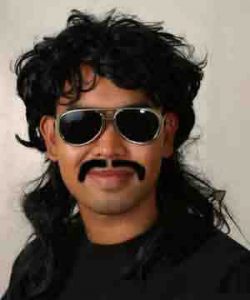
Male model impersonating the appearance of Jerry Mirliani Circa 1967-1972
‘HIGHER, FASTER, AND LOUDER’ as to players who play ‘PHYSICAL’.
Between 1967 and 1972, the two trumpet player students that Professor Chesnut would have labeled as playing ‘PHYSICALLY’ all too often to Professor Chesnut’s liking would have been Bob, and Jerry Mirliani [’69]. After getting his BA in Music Education in ’69, Jerry went on to get his Masters in Music Education as well as Professor Chesnut’s Graduate Trumpet Teaching Assistant. After getting his Masters in Music Education in the early 1970’s, Jerry Mirliani toured as lead trumpet player with the Tommy Dorsey Orchestra.
Walter Chesnut’s Personality
Professor Walter Chesnut had by far the most ebullient personality of anyone Bob has ever met. To say that Professor Chesnut was always upbeat and cheerful would be
an understatement. Professor Chesnut’s expressive facial features and cheerful, upbeat personality were charismatic. People of every description were naturally drawn to him and he always made everyone around him instantly at ease.
When Bob performed a passage that was pleasing to Professor Chesnut’s ears during a trumpet lesson, Professor Chesnut would break out in a broad grin.
When Bob performed a passage that Bob was having trouple working through in a manner that was finally acceptable to Professor Chesnut, Professor Chesnut would exclaim, YES! YES! YOU GOT IT! – SOUNDS GREAT! – TIME TO MOVE ON!
Professor Chesnut had an exceptionally patient disposition and always encouraged Bob to perform to the best of Bob’s ability even though that effort might have fallen short of anyone’s definition of ‘BEST’!.
The 12 areas that Professor Chesnut directed Bob to approve upon that are referenced above were particularly challenging from 1967 and 1969 in particular. Bob’s improvement in these 12 areas would always seem to plateau for a period that lasted at least 3 to 4 weeks and sometimes for multiple months at a stretch. Then, Bob would have a break through that lead Professor Chesnut to exclaim, “I KNEW YOU COULD DO IT! GREAT JOB!”
Professor Chesnut’s ability to be endlessly patient, never belligerently critical, and always optimistic continue to be eternally appreciated by his student, Bob.

This is an impression of what Walter Chesnut would look like when he really “WIGGED OUT“!
Only on the very rarest of occasions would Professor Chesnut show irritation or anger in particular. On the rare occasion that Professor Chesnut would become irritated about something, Professor Chesnut would exclaim, “THIS IS CAUSING ME TO WIG OUT!” Or, “I THINK I AM WIGGING OUT” …Or, “I AM GOING TO WIG OUT!” Or, “YOU ARE WIGGING ME OUT!”.
On two occasions between 1967 and 1972, Professor Chesnut’s student Bob, witness Professor Chesnut REALLY “WIG OUT” on two occasions.
Both of these events are described by viewing:
Trumpet History Tour Hotel Brothel in Vienna
and
Vienna Prostitution Scandal Involving Professor Wally Chesnut Travels To UMASS-Amherst
Walter Chesnut’s Interest In Trumpet History
The seeds of Professor Walter Chesnut’s profound interest and understanding of all things related to Trumpet History evolved from Professor Chesnut’s great love of listening to and performing musical literature composed during the high Baroque Era which dates to 1600-1750.
Professor Chesnut was fascinated with the compositions of J.S. Bach, Handel, Vivaldi, Purcell, Scarlatti, Telemann, and Corelli that were most heavily reliant on the use of the high baroque trumpet style of play in an orchestral setting.
The high baroque trumpet performances of German trumpet player, Adolph Scherbaum (1909-2000) impressed Professor Chesnut in the early Fall of 1967.
The high baroque trumpet performances of Armando Ghitalla (1925-2001) , Principal Trumpet with the Boston Symphony equally impressed Professor Chesnut in the early Fall of 1967.

Maurice Andre Holding a Selmer 4 Piston Valve Piccolo trumpet that he personally designed.
By late 1967, the name of an extraordinary French Trumpet Virtuoso named Maurice André begun to gain enormous recognition in the United States through a large number of beautifully recorded vinyl recordings. The large majority of the recordings featured Maurice Andre’ playing a 4 Valve Piccolo trumpet that he personally helped design that was produced by Selmer in Paris. And, the music that Maurice Andre’ performed to the highest standards of musical performance on the Piccolo trumpet was music composed during the high Baroque Era.
Almost all of the Maurice Andre’ recordings in the 1960’s were produced by small European labels such as. the Telemann Society, Erato and a bit later the larger Philips label. And, these fine recordings were licensed for reproduction by the Musical Heritage Society in the United States.
The Musical Heritage Society, was an American mail-order budget record label founded in
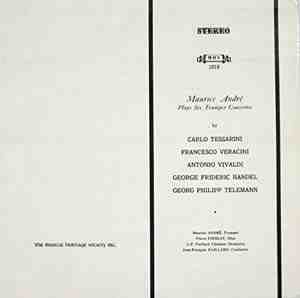
Typical white jacket with black type vinyl lp recording jacket used by the Musical Heritage Society.
New York City in 1962 by Michael “Mischa” Naida, (1900–1991), co-founder of Westminster Records, and T. C. Fry Jr. (1926–1996).
Back in the 1960’s, all of the vinyl LP recording jackets were inexpensive plain white with simple black lettering. This reduced costs significantly. But, the quality of the vinyl pressings themselves was excellent.
The Musical Heritage Society mail order budget business model targeted the Classical Music Education Market place.
By the end of 1970, Bob had acquired at least 30 Maurice Andre’ LP recordings by way of the Musical Heritage Society.
Needless to say, the performances of Maurice André super impressed Professor Walter Chesnut.
In early Spring of 1969, Professor Chesnut obtained five or six excellent seats for a Maurice Andre’ New York Town Hall Recital Hall debut at that time on a Sunday afternoon.
Bob and fellow UMASS trumpet performance major, Doug Purcell were part of the group of trumpet players that traveled with Professor Chesnut to New York City in Professor
Chesnut’s massive Pontiac Station Wagon.
The Maurice Andre’ Recital was extraordinarily impressive. Within two weeks after the performance, both Professor Chesnut and Bob had purchased Selmer brass plated 4 Valve Piccolo trumpets. And, Doug Purcell purchased an excellent 4 Valve Silver plated Getzen Piccolo trumpet.
For a detailed account of the Maurice Andre’s Town Hall Recital debut, see Most Important Classical Trumpet Soloists Prior to 1970.
(Between 1967 and 1972, Professor Chesnut, Doug Purcell, and Bob were the only three trumpet players associated with UMASS that performed on the Piccolo trumpet.)
Not long after the Maurice Andre’s Town Hall Recital debut performance, a great deal of performance literature that Professor Chesnut introduced to Bob revolved around the High Baroque Era.
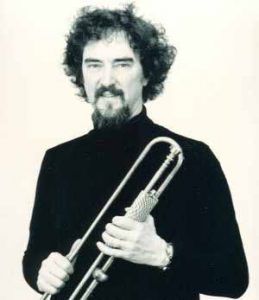
Edward Tarr holding a natural, Baroque trumpet.
By the Fall of 1969, Professor Chesnut began to hear about Edward Hankins Tarr (born June 15, 1936) Edward is a fine, classically trained American trumpet player and ground breaking musicologist. In 1953, Edward was a student of Roger Voisin, principal trumpet of the Boston Symphony Orchestra, and in 1958–1959 with Adolph Herseth, principal trumpet of the Chicago Symphony.
Early in his musical career, Edward Tarr moved to Europe and began his first trumpet soloist as well as brass ensemble recordings in 1960. In 1971, Edward resided in Basel Switzerland. In the late 1960’s Edward Tarr blossomed into becoming an internationally recognized pioneer in the revival of late Renaissance, Baroque (in particular) and Romantic era trumpet performance practice.
In 1968 the Edward Tarr Brass Ensemble was formed, the only one of its kind – with four trumpets and four trombones. Modern as well as antique instruments were used to perform Renaissance and Baroque music as well as modern works.
The recording that put Edward Tarr on the ‘map’ was released by Nonesuch Records in 1969 that was entitled “The Art Of The Baroque Trumpet”.
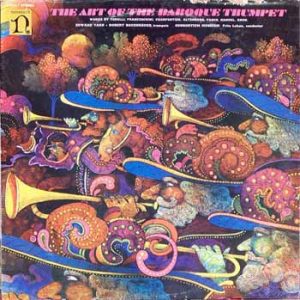
The Art of the Baroque Trumpet featuring Edward Tarr
The musical performances on trumpet as well as the accompanying orchestra were performed on musical instruments that were obtained from European Museums that were not used for live performance purposes for hundreds of years.
The trumpets were “Natural Trumpets” which are often referred to as ‘Baroque Trumpets’… A natural trumpet is a long, double-folded trumpet without valves. It was the trumpet used across Europe from the 15th through the mid 19th centuries, and is a common ancestor to all modern brass instruments. It is the trumpet that composers like Bach, Handel, Mozart, and Beethoven wrote for, and has had a resurgence in the past 50 years, since the late 1960’s in the performance of Baroque and Classical-era music.
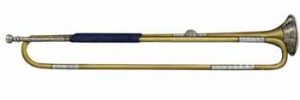
Natural – Baroque Trumpet
For additional information on Baroque or Natural Trumpets see…https://en.wikipedia.org/wiki/Baroque_trumpet
In early Fall of 1969, Professor Chesnut scheduled a ‘special group class’ where attendance was mandatory for all his trumpet students. Wally played for the class his own personal copy of the Edward Tarr recording entitled “The Art Of The Baroque Trumpet”.
Professor Chesnut was super enthusiastic about the significance of this recording and all of the student trumpet players were also impressed.
Wally Chesnut became so impressed with Edward Tarr’s own trumpet history and natural Baroque trumpet performances that Wally devoted the remainder of his professional trumpet teaching career advancing his own knowledge as well his students knowledge of the history of the trumpet. Here is a snippet on YouTube of Wally conducting a ‘History of the Trumpet’ demonstration…that appeared to be recorded in 1991.
In late 1970, Wally Chesnut ‘got wind’ of a European Trumpet History Tour that was being organized by Edward Tarr. Edward Tarr was organizing a 14 day European Trumpet History Musicological tour that was scheduled during the 1971 UMASS-Amherst College Spring Break time frame.
Because Bob Amato had already developed a keen interest in performing music literature of this era…and, also had developed reasonable proficiency in performing the demanding high, (clarino) register trumpet parts on his own Schilke D/E♭ and Selmer 4-Valve Piccolo trumpets, Wally Chesnut encouraged Bob to accompany Wally on the Edward Tarr European Trumpet History Tour.
Ultimately, Professor Wally Chesnut helped his student, Bob Amato obtain either a scholarship or grant that fully funded Bob’s participation in the Edward Tarr European Trumpet History Tour.
The approximate two week Edward Tarr European Trumpet History Tour was a once in a lifetime, unforgettable experience. For complete tour details, see Edward Tarr European Trumpet History Tour.
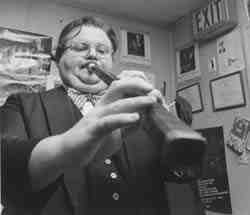
Walter Chesnut – UMASS Trumpet Instructor playing a Cornetto circa 1978.
After returning from the Edward Tarr European Trumpet History Tour in the Spring of 1971, Professor Chesnut became immersed in everything he could find out about the “History of the Trumpet”.
Edward Tarr provided the Tour Members, with a source that manufactured historicallyaccurate Natural – Baroque Trumpets. Professor Chesnut purchased one and then additional models of the Natural – Baroque Trumpet.
While performing research on this essay, Bob learned that by 1975, Professor Chesnut began routinely performing demonstrations and seminars regarding the “History of the Trumpet” that involved live performance demonstrations of the various types of Natural-Baroque trumpets that were used in the Medieval, Renaissance and Baroque Era time periods.
Walter Chesnut Mouthpiece Selection
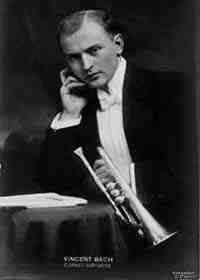
Vincent Bach – Virtuoso Cornet Soloist Circa early 1920’s.
In 1918, Austrian born, but later New York based trumpet and cornet virtuoso, Vincent Bach (1890-1976) founded the Vincent Bach Corporation which to this day manufactures fine professional grade brass instruments as well as brass instrument mouthpieces. See Bach Mouthpieces as well as:
https://en.wikipedia.org/wiki/Vincent_Bach_Corporation
By the late 1960’s the Bach 7C trumpet mouthpiece was the most popular trumpet mouthpiece in the world. A large majority of young beginner trumpet players would begin on the Bach 7C trumpet mouthpiece. And, a large number of these players who became professionals in the ‘commercial’, non-classical field in particular continued to use this fine mouthpiece through their entire performance careers.
Bob utilized the Bach 7C mouthpiece when he arrived at UMASS-Amherst at started taking
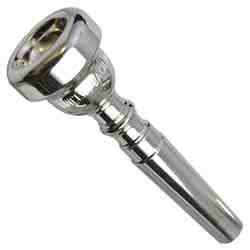
Bach 7C Trumpet Mouthpiece that the Author of this essay performed on for many years.
trumpet lessons with Professor Walter Chesnut in September of 1967.
In the 1950’s, classical trumpet players who performed in Symphony Orchestras began
gravitating to trumpet players with a wider rim size than the Bach 7C. The wider rimmed Bach mouthpiece that orchestral trumpet players began to favor was a Bach 3C which tended to provide a somewhat richer, darker and more sonorous tone quality than the Bach 7C trumpet mouthpiece.
Broadly speaking, the larger and deeper the cup, the darker the tone and greater the volume the trumpet can produce.
For most of the first half of the century orchestral trumpet players preferred
mouthpieces with moderately-sized cup diameters and somewhat smaller throat and
backbore sizes than seen with cornet-like mouthpieces of the late 1800’s. However, a
trend toward larger cup diameters developed in the late 1950’s among orchestral trumpet
players in the United States. One of the many factors that led to this trend involved
Adolph “Bud” Herseth, principal trumpet of the Chicago Symphony from 1948 to 2001.
In 1952, Bud Herseth was involved in an automobile accident and sustained severe
damage to his lips and teeth. Due to severe scar tissue problems he was forced to switch
from a Bach 7 rim (the mouthpiece which he began his CSO tenure with) to a much
larger Bach 1 rim. Bud Herseth went to a very large Bach 1 1/2C mouthpiece.
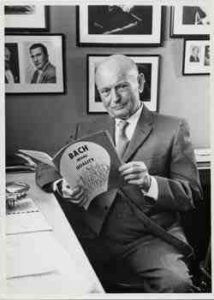
Vincent Bach circa 1965
The significantly wider rimmed Bach 3C and Bach 1 1/2C also made it easier to produce a warm, rich, and sonorous tone quality than the Bach 7C or Bach 5C mouthpieces. The sacrifice was that unless the player was particularly well a developed, the playing in the higher registers beginning with G above the staff could become more and more difficult as the range of the trumpet approached High C and beyond.
As many trumpet players emulated Bud Herseth’s extraordinary orchestral trumpet playing and magnificent tone quality, orchestral players in Boston and New York in particular soon began using significantly larger mouthpieces also. The use of the Bach 1 1/2C trumpet mouthpiece became quite common in major Symphony Orchestras in the United States by 1970.
Many professional jazz and commercially oriented trumpet players derisively referred to symphonically oriented trumpet mouthpieces with a cup rim diameter wider than a Bach 5C as ‘Toilet Bowl’ mouthpieces.
In September of 1967, Professor Chesnut was using a Bach 3C trumpet mouthpiece. And,

Walter Chesnut teaching his best trumpet student, Doug Purcell, circa early 1968 in Professor Chesnut’s UMASS Music Department provided mobile home teaching studio.
by about that time frame, Professor Chesnut’s best student, Doug Purcell was using a Bach 3C mouthpiece as well. Professor Chesnut’s other excellent student trumpet player, Jerry Mirliani may not have switched to a Bach 3C mouthpiece at that time. However, by the Spring semester in 1968, with great certainty, Jerry Mirliani migrated to a Bach 3 C trumpet mouthpiece. And, by the Spring of 1968, both Professor Chesnut and his best student, Doug Purcell were using Bach 1 1/C trumpet mouthpieces.
Bob never used a Bach trumpet mouthpiece with a rim larger than a Bach 7C Over an approximately 18 month period that started in the Fall of 1967 and ended by the end of 1968, Professor Chesnut encouraged Bob to stop using the Bach 7C trumpet mouthpiece and go with the larger Bach 3C rim size. Whenever Bob tried using the Bach 3C mouthpiece he felt an immediate loss of all performance skills.
However, sometime in the summer of 1971 Bob switched to a custom Zottola
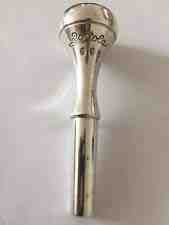
Zottola 66C Trumpet Mouthpiece.
’66A’ trumpet mouthpiece that Bob used exclusively into 1975 on B Flat, C, and D/E Flat trumpets as well as Cornet, and a 66FL for the flugelhorn as well. Bob always used exclusively,with excellent success a Bach 10 1/2 C trumpet mouthpiece on Piccolo trumpet without any difficulty whatsoever switching between these two mouthpieces.
Frank Zottola was a master machinist who operated a workshop out of his home in Port Chester, New York. Frank had a very sweet, enthusiastic, and engaging personality and was extremely knowledgeable about trumpet mouthpiece designs. And, Frank had one interesting concept. This concept was machining into the otherwise smooth backbore of the trumpet mouthpiece a series of ‘5 steps’ whose rational for being developed made sense to Bob.
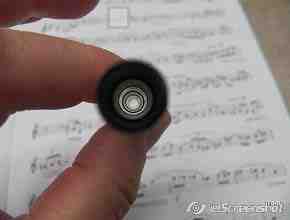
Approximate 5 Step Zottola Backbore trumpet mouthpiece.
Bob heard about Frank Zottola’s unique trumpet mouthpiece designs by way of a small display advertisement that Frank ran in the monthly newspaper published by the American Federation of Musicians Union.
Bob wrote to Frank Zottola and requested a brochure. Bob reviewed the info brochure and made an appointment to drive to Frank’s home on a weekend morning.
Bob spent well over an hour playing on various Zottola trumpet mouthpiece designs that ranged from a medium rim 64 to the widest 66 rim size. Bob purchased one of these mouthpieces, and to Bob’s amazement Frank Zottola told Bob to take ‘on approval’ on in unsolicited basis, another five or six mouth pieces. Frank trusted Bob to return unwanted mouthpieces to Frank.
During the summer of 1971, but went with a 66A Zottola trumpet mouthpiece. This was a large cup – at least the equivalent of a Bach 5C with a deep cup. This mouthpiece provided a richer more sonorous tone than the Bach 7C. When Bob returned to UMASS in September 1971, Professor Chesnut did not have a problem with the tone quality that Bob produced with the rather large 66A Zottola trumpet mouthpiece.
In 1975, when Bob started playing commercially almost on an exclusive basis, Bob settled

Frank Zottola with his young son Glenn who matured into a fine professional Jazz and Commercial trumpet player in New York City.
on a ’66DW’ design. However, Bob wanted to ‘darken the sound’ a bit, and enable this mouthpiece to be a bit more ‘free blowing’. With extremely small well calibrated metal drill bits, Frank gradually opened the throat incrementally to a degree that Bob felt comfortable with. For use on all trumpet models accept Piccolo trumpet, Bob used this Zottola mouthpiece design for the remainder of his playing career.
This particular Zottola mouthpiece provided an enormous degree of flexibility. Even at thunderous, ear splitting volumes up to G above High C, this mouthpiece would continue
to produce a tone quality that was not excessively shrill or overly bright sounding. Whether playing pianissimo or triple forte fortissimo into the high register the sound quality of this mouthpiece could be controlled quite well.
With regards to what the code, ’66DW’ represents, according to http://users.rcn.com/rakright/
66D LARGE SHALLOWER By decreasing cup depth slightly while maintaining a wide diameter, a radical boost in range will be achieved without sacrificing volume.
Without the benefit of fine machinist grade measuring instruments, it is impossible to accurately compare the measurements of a Bach mouthpiece to this Zottola ’66DW’ trumpet mouthpiece.
However, a visual inspection of the Zottola ’66DW’ reveals that the cup diameter is somewhat wider than a Bach 7C trumpet mouthpiece. And, the cup depth appears to be no shallower than the Bach 7C trumpet mouthpiece. The ‘W’ indicates that the with of the Zottola trumpet mouthpiece rim is slightly wider providing a larger ‘cushion’ than the standard rim of a Zottola trumpet mouthpiece. The ‘D’ rim on this Zottola mouthpiece is wider than the standard Bach 7C mouthpiece. Bob found that the wider Zottola trumpet mouthpiece rim enabled Bob’s endurance to increase to a notable degree without the loss of accuracy or advanced flexibility drills. Bob could perform perform very accurate ascending and descending chromatic ‘lip trills’ from Middle C to G above High C with great consistency with this mouthpiece. Supposedly, wider rimmed mouthpieces cause flexibility of this nature to be inconsistent.
The remaining mouthpiece that Bob used extensively for use exclusive to the Selmer 4 Valve Piccolo trumpet that was never recommended by Professor Chesnut was a Bach 10 1/2C that came ‘bundled’ with the Selmer Piccolo trumpet Bob purchased shortly after the early 1969 Maurice Andre’ Town Hall recital referenced above.
The Bach 10 1/2C trumpet mouthpiece will be discussed in much detail in the next section regarding Walter Chesnut’s Trumpet Selection.
For more excellent and detailed information on trumpet mouthpiece history, CLICK HERE!
Walter Chesnut Bb Trumpet Selection
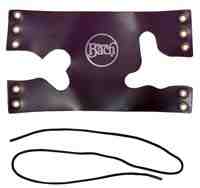
Old fashioned lace-up style trumpet valve guard.
When Bob arrived at UMASS in September of 1967, Bob was performing on a beginner grade, Holton Collegiate model brass plated Bb trumpet that Bob had been playing since he was ten years old in the Fifth Grade. Much of the clear lacquer that protected the brass had worn off. The acid from Bob’s skin had caused substantial corrosion to develop. Deep pitting around the exposed brass metal parts where Bob placed his hands severely marred the appearance of this trumpet. The outside of the three valve casings in particular were a complete mess. Within a few years or less the valve casings would have been worn through completely. By the time Bob was a Junior in
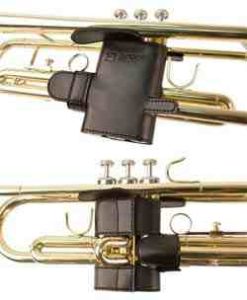
Modern velcro secured trumpet valve guard.
high school, the brass corrosion was so bad that the palms of Bob’s hands would turn green from handling this old badly corroded trumpet. At that time, Bob’s High School Band Director, Joe Salerno who was also a trumpet player suggested Bob purchase a heavy brown leather, laceup, valve casing protector sleeve that protected Bob’s hands from turning green and the valve casings from further corrosion. However, the small 2nd valve slide remained a complete corrosive mess and be exposed to further deterioration.
Walter Chesnut Bb Trumpet Selection
In a nutshell, this beginner grade Holton Collegiate B Flat trumpet was at the end of its useable lifecycle and needed to be replaced as soon as possible. When Bob was 10 years old in 1959, Bob’s parents did a rent to own purchase agreement on this trumpet which cost $55.00 including a case and a Bach 7C mouthpiece. The payment plan was $2.00 a month over 28 months to own this instrument.

Bach Stradivarius Model 37 Bb Trumpet with brass plating
Bob recalls that Professor Chesnut personally used a brass plated Bach Stradivarius trumpet in 1967. However, by the 1969 and 1970 time frame, all of the trumpets that Professor Chesnut utilized were silver plated and produced by Schilke in Chicago.
Also, the UMASS-Amherst Music Department owned nine excellent, Bach Stradivarius
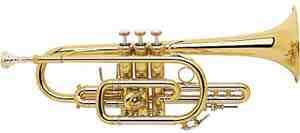
Bach Stradivarius Model 25 Brass Plated Cornet used with the UMASS Symphony Band.
Brass plated cornet that were issued to the nine members of the fine UMASS Symphony Band each school year under the able Direction of Professor John Jenkins.
Professor Chesnut suggested to Bob that he purchase a new brass plated Bach Stradivarius B Flat trumpet with a Medium Large Bore and probably either a 37 or 43 bell size.
Bob purchased this trumpet which included a beautiful Bach case, a Bach mouthpiece size of Bob’s choosing, and a bottle of Bach valve oil for well under $300.00 in the fall of 1967 from John Coffey Music in Boston. Coffey Music maintained a large inventory of trumpets of all descriptions from all of the many large trumpet manufacturers in the World accept for Schilke. And, Coffey Music would provide a steep 40-45% discount to all comers below manufacturer suggested retail price.
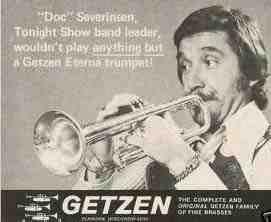
Getzen Eterna Severinsen Model Bb Trumpet with silver plating advertisement circa early to mid 1970’s.
In late 1969 or early 1970, Bob tried out the Getzen B flat trumpet that was personally designed to the specifications of Doc Severinsen. This model was called the Getzen Eterna Doc Severinsen model. Bob was introduced to this model by a trumpet player in Boston who he was friends with who played in a top drawer Blues Band called ‘Swallow’ which featured an excellent five man horn line.
The Getzen Eterna Doc Severinsen model was a terrific B Flat trumpet that was every bit the professional grade that the Bach Stradivarius B Flat trumpet line was.
And, Getzen Eterna Doc Severinsen model trumpet featured an interesting premium feature that no other trumpet manufacturer in the World utilized prior to the late 1969 time frame.
The premium feature Getzen Eterna Doc Severinsen model trumpet utilized was the Amado Water Key which was invented by Raymond A. Amado. Mr. Amado was awarded United States Patent Number US3625104 in 1971.
After Bob purchased the Getzen Eterna Doc Severinsen model trumpet (possibly the large bore model), Bob brought both the Bach Strad and the Getzen to his next trumpet lesson with Professor Chesnut.
Although Professor Chesnut was suspicious of Trumpet manufactures that were neither Bach or Schilke, Professor Chesnut did hear good things about the Getzen line of trumpets.
At the initial lesson, Professor Chesnut tried playing the Getzen Eterna Model and was quite impressed. In particular, Professor Chesnut really was impressed with the Amado Water Key/Spit Valve feature.
A careful view of the photograph of Professor Chesnut at the top of this page that was taken around 1970 shows four trumpets with no evidence of the traditional lever/spring water key. It is quite probable that Professor Chesnut converted all of his various Schilke Trumpet models to the Amado Water Key water condensation evacuation system.
Walter Chesnut C Trumpet Selection
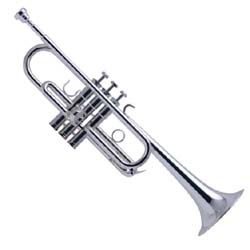
Schilke Silver Plated C Trumpet
Beginning in the early fall of 1968, Professor Chesnut encouraged Bob to acquire a Schilke C Trumpet. Bob acquired a new silver plated Medium Large Bore Schilke C Trumpet at this time.
It took Bob at least 4 to 6 weeks of daily practice on this excellent C trumpet to get used to the playing charactics which Bob found to be different than the Bach Bb trumpet Bob was using up to this point.
However, with the assistance of key transposition studies, and daily practice, the C trumpet became Bob’s preferred trumpet until the Spring of 1975 when Bob became a full time commercial trumpet player. With the exception of big band, jazz, theatre, and rock band oriented gigs, performance literature that required other types of trumpets, Bob used the C trumpet almost exclusively until the Spring of 1975. The transposition of Brass Ensemble literature that was frequently written for Bb trumpet became second nature by the end of the Spring 1969 semester.
Walter Chesnut Eb/D Trumpet Selection
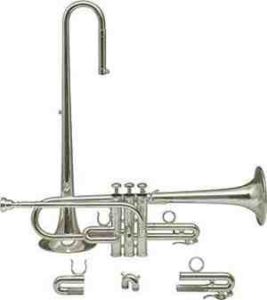
Schilke Eb/D Trumpet Silver Plated with removeable tuning bell design and tuning slide kit.
Around November of 1968, perhaps a month after Bob acquired the Schilke C trumpet, Professor Chesnut urged Bob to acquire a Schilke Eb/D Trumpet directly from Schilke in Chicago. This was a ‘used’ used Schilke Eb/D Trumpet that was not factory refurbished in any way. Professor Chesnut was on the Schilke ‘used trumpet’ mailing list and Professor Chesnut just got the current Schilke ‘used trumpet’ offerings list in the mail from Schilke. Professor Chesnut told Bob that if Bob did not purchase this ‘used’ Eb/D Trumpet right away, Professor Chesnut would buy this horn even though he already had an Eb/D trumpet. Bob recalls that Professor Chesnut may have owned a brass plated Bach Eb/D trumpet in this time frame.
This ‘used’ Schilke Eb/D Trumpet was recently traded in for a new Schilke model by the brilliant Frank Kaderabek and ALSO
Frank Kaderabek was the Principal Trumpet with the Detroit Symphony until 1975. And,
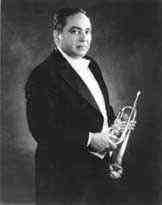
Frank Kaderabek – Principal Trumpet Philadelphia Orchestra and considered one of the very best orchestral trumpet players in the later third of the 20th Century.
from 1975 to 1995, Frank Kaderabek was the Principal Trumpet with the Philadelphia Orchestra.
For the latter third of the 20th Century, Frank Kaderabek was considered to be one of the very finest Orchestral trumpet players in the entire world.
This ‘used’ Schilke Eb/D Trumpet was in poor condition cosmetically. Although there were no dents anywhere, much the silver plated finish was worn down to the bare brass finish where the hands contacted the trumpet. And, the brass metal finish in these areas was badly worn with some pitting. In this regard, this used Schilke Eb/D Trumpet was cosmetically similar in shape to the beginner grade Holton Collegiate Bb trumpet that Bob stopped using in the early fall of 1967.
However, this ‘used’ Schilke Eb/D Trumpet was priced around 30 percent of a shiny new model and Bob made the purchase.
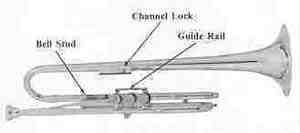
Schilke Removable Tuning Bell Design
The Schilke Eb/D trumpet had a terrific detachable tuning bell design. The player would change bells and various slides to achieve the desired Eb or D pitch on this fine trumpet.
This particular ‘used’ Schilke Eb/D Trumpet that was previously owned by Frank Kaderabek, was a fantastic horn. (Bob had a one hour private trumpet lesson with Frank Kaderabek in the Fall of 1974 and Bob brought this horn with him to this lesson. Frank remembered the horn and told Bob he wished he kept it.)
Bob had little difficulty becoming acclimated to this Frank Kaderabek ‘used’ Schilke Eb/D Trumpet. This Schilke Eb/D Trumpet produced a beautiful clear tone, great intonation, with excellent response in all registers.
This Schilke Eb/D Trumpet was also capable of producing an enormous volume of sound without shrillness that would contend with a larger, well made Bb trumpet.
Walter Chesnut Piccolo Trumpet Selection

Paris Selmer Model 59/Maurice Andre Model Piccolo Trumpet
As noted above, within two weeks after Maurice Andre’s Town Hall Recital debut, both Professor Chesnut and Bob had purchased Selmer brass plated 4 Valve Piccolo trumpets. And, Doug Purcell purchased an excellent 4 Valve Silver plated Getzen Piccolo trumpet. Bob cannot remember where Professor Chesnut purchased his own Selmer brass plated 4 Valve Piccolo trumpets. However, Bob drove to Coffey Music in Boston right after Coffey Music just acquired five Selmer brass plated 4 Valve Piccolo trumpets. The one Bob picked out was a ‘Dandy’ to say the least! Probably from Coffey Music in Boston, Doug Purcell purchased the 4 Valve Silver plated Getzen Piccolo trumpet.
The smallest of the trumpet family is the piccolo trumpet, pitched one octave higher than the standard B♭ trumpet. Most piccolo trumpets are built to play in either B♭ or A, using a separate leadpipe for each key.
All five of the Selmer brass plated 4 Valve Piccolo trumpets that Bob tried out at Coffey Music in Boston came ‘bundled’ with a Bach 7D mouthpiece. The significance of the Selmer brass plated 4 Valve Piccolo trumpet paired with the Bach 7D mouthpiece did not become known to Bob until around 2005. At that time, Bob learned that Maurice André always used the Bach 7DW mouthpiece when he performed on the Selmer Piccolo trumpet. André used a Bach 1 1/2C when he performed on Bb, C, and Eb/D trumpets.
At Coffey Music in Boston, Bob received aid with the Selmer Piccolo trumpet selection as well as a suitable mouthpiece for this trumpet from a part time store salesman by the name of Ben. Ben was a graduate trumpet major at Boston University, and a student of Armando Ghitalla. Ben was an excellent trumpet player and suggested to Bob that Bob try using the Bach 10 1/2C mouthpiece rather than the 7D that came bundled with the Selmer Piccolo trumpet. The Bach 10 1/2C mouthpiece proved to be ‘magic’ and Bob continued to use this mouthpiece exclusively on Piccolo trumpet with excellent results through the remainder of his professional playing career.
Learning to play the Piccolo trumpet back in early 1969, was a whole new world for Professor Chesnut, the exceptional Doug Purcell as well as Bob. There was no teaching literature specific to learning how to play the Piccolo trumpet. The best one could do is listen to numerous exceptional Maurice André and do your best to emulate Andre’s extraordinarily beautiful tone and superlative musicianship and lyrical phrasing capabilities.
Although Bob cannot speak for his old friend, Doug Purcell, Professor Chesnut did not provide any specific guidance that was specific to learning to play the Piccolo trumpet.
The Selmer 4 Valve Piccolo trumpet came equipped with two different lead pipes whose throat would accommodate a standard trumpet mouthpiece rather than a cornet or flugelhorn mouthpiece. The different length lead pipes enabled to tune the piccolo trumpet for Bb and A usage. This easy change of tuning to A was quite useful in playing Baroque musical literature that was written in D Major in particular.
With regards to Professor Chesnut’s own play on the Selmer 4 Valve Piccolo trumpet, Professor Chesnut never spent the time to develop a high register than extended much beyond a written High D above High C on a Bb trumpet or ‘Concert High C’. However the sound quality that Professor Chesnut produced within the playing registers of his personal comfort zone was excellent. It is likely that Professor Chesnut utilized the same 1 1/2C Bach mouthpiece that he utilized when he performed on Bb, C, and Eb/D trumpets. And, Professor Chesnut began to produce an excellent sound on the Selmer 4 Valve Piccolo trumpet up to the limit of his customary high register rather quickly.
Doug Purcell UMASS-Amherst Trumpet Performance Major
Doug Purcell who went with the 4 Valve silver plated Getzen piccolo trumpet was an outstanding trumpet player and the Author of this essay will digress and discuss Doug Purcell’s musical gifts on trumpet.
Doug Purcell was a two or three years ahead of Bob at UMASS-Amherst and Doug had apparently developed advanced trumpet playing skills at a young age. Doug played first chair trumpet with the Boston Youth Orchestra when he was a senior in high school.
In the Fall semester of 1967, Bob was 17 years old and Doug Purcell played 1st chair cornet with the Symphony Band and 1st chair trumpet with the UMASS-Amherst Symphony Orchestra.
In the Fall of 1967, Professor Chesnut scheduled Doug Purcell to perform a student recital with Doug performing ‘Prayer of St. Gregory’ (1946) by Alan Hovhaness with Piano Accompaniment. For some reason, this performance took place in a ‘sit down’ classroom environment that seated an audience of around 30 people…probably mostly trumpet players rather than the much larger customary student recital hall.
Doug Purcell’s interpretation of the ‘Prayer of St. Gregory’ was sublime and unforgettable. Doug’s tone quality and phrasing were magnificent. Doug is a trumpet player who is governed by musicality without the need to impress with pyrotechnics. Doug Purcell produced an elegant sound quality coupled with innate musicality that communicates with the listener by interpreting a melody in a similar manner that a vocalist or string player with virtuoso skills would perform.
Doug Purcell produced an extraordinarily beautiful sound quality and elegant musicality that was amplified by impeccable intonation and a perfect sense of time that this Author always admired and found unforgettable to this very day. This Author has worked with many scores of professional trumpet players over the years whose tone quality this Author has heard in person. Separately from either Maurice André and Doc Severinsen, the only trumpet players that this Author has heard in person whose tone quality measured up to the tone quality that Doug Purcell produced was Don Tison, Frank Kaderabeck, and Sweet Willie Singleton.
This Author spent countless hours over many, many years practicing in a manner that this Author hoped would emulate the tone quality of Doug Purcell to no avail.
Between 1967 and the early Spring of 1975, this Author performed a great deal with Doug Purcell including, band, orchestra, multiple trumpet duet performances, and brass ensemble performances which included the Berkshire Brass Quintet in 1974 and 1975. Although this Author played the 1st trumpet part in many of these performances, this Author always felt that the extraordinary musicianship that Doug Purcell brought to the table is what really carried the day.
With regards to Doug Purcell’s trumpet practice habits, this Author is completely clueless. Doug married his High School sweetheart Judy right after High School and began developing a family. Doug and his growing young family lived off campus in an apartment. Other than at ensemble performance rehearsals, this Author never heard Doug Purcell practice any exercises or any etudes of any kind on the trumpet. Prior to rehearsals, Doug would perform a simple, short warmup and that was it. And, between 1967 and the early spring of 1975, this Author never heard Doug miss one single note. Doug always performed flawlessly.
This Author has often felt that Doug’s trumpet playing skills were so advanced from a young age that he never needed to practice very much to perform to such a high caliber.
Doug Purcell was the 1st person to be awarded a BA in Trumpet Performance at UMASS-Amherst. After the BA in trumpet performance, Doug was awarded a Master in Music Education at UMASS-Amherst. Doug spent his entire professional career in the Amherst, Massachusetts area where he served as the Music Director for the Amherst Public School System for about 40 years.
This Author has always felt that if Doug was so inclined, he would have been a first rate trumpet player with any of the world’s greatest Symphony Orchestra’s.
Getting back to the piccolo trumpet, Doug Purcell seemed to adjust to playing the silver plated 4-Valve Getzen piccolo trumpet very quickly using what was probably his Bach 1 1/2C mouthpiece. And, the quality of the tone that Doug produced on the piccolo had every bit the vibrant integrity that he also produced on the larger Bb, C, and D/Eb trumpets.
Walter Chesnut 1971
The major 1971 event that involved Professor Chesnut and this Author, was the approximate two week Edward Tarr European Trumpet History Tour referenced earlier in this essay.
Near the end of the Spring 1971 semester, Professor Chesnut began working with Bob in putting together a suitable program for Bob’s upcoming 1972 senior graduation trumpet recital. Professor Chesnut wanted Bob to work on performance literature over the summer of 1971. More on this process can be found at Plan Senior Graduation Trumpet Recital.
Walter Chesnut 1972
The early part of the Fall 1971 Semester was spent working out the details for the Spring 1972 Semester when this Author’s senior graduation trumpet recital would be performed.
Preparation for other routine student recital solo trumpet and brass ensemble performances were worked on as well.
In the Spring 1972 Semester, Bob also began a ‘Student Teaching’ assignment at Ware High School in Ware, Massachusetts which was the last requirement to be awarded a teaching certificate and a BA in Music Education. Sadly, the Ware, Massachusetts band director was completely incompetent and Bob realized that a life of teaching music in a public school system would not be a wise career choice.
In March of 1972, the combined Glee Clubs of Mount Holyoke College (Catharine Melhorn Director) and the University of Virginia (Donald Leach) offered to hire Bob as a featured trumpet soloist and as well as 1st trumpet in an approximate 30 piece chamber orchestra. This was a two week tour into Virginia as well as North and South Carolina.
Bob accepted this position and discontinued the student teaching assign in Ware, Massachusetts and never completed the BA in Music Education final requirement.
Bob’s senior trumpet recital was a resounding success and other than the very poor student teaching experience, the 1972 school year was both memorable and very productive.
Walter Chesnut 1973
Although Bob’s trumpet instruction with Professor Chesnut discontinued at the end of the Spring 1972 semester, Bob kept up with Professor Chesnut.
Professor Chesnut received a phone call from Tamara Brooks who was the newly appointed Cyprus National Chamber Orchestra music director. Tamara Brooks was the outstanding Director and Conductor of the all female, Mt. Holyoke College Glee Club in South Hadley, Massachusetts.
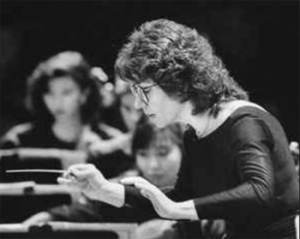
Tamara Brooks – Conductor Cyprus National Chamber Orchestra circa early 1970’s
Between 1969 and 1972, Tamara Brooks had hired UMASS trumpeters Wally Chesnut, Bob Amato, and Doug Purcell both separately and jointly to perform in various Baroque music performances performed at Mt. Holyoke College as well as Mt. Holyoke College Glee Club tours that typically took place during ‘spring breaks’. Tamara Brooks was looking for a trumpet player that was capable of performing Bach’s Brandenburg Concerto Number 2 and knew that Bob was capable if he was available.
The Professor Chesnut referral to Tamara Brooks resulted in Bob being hired as the 1st Trumpet and featured soloist with the Cyprus National Chamber Orchestra which was Bob’s first full time engagement as a professional trumpet player.
Because of civil strife between the ethnic native Greek and Turkish populations in Cyprus, the Cyprus National Chamber Orchestra 1973 was cut short and non-Cyprus citizens were forced to evacuate Cyprus under armed escort around August 1st, 1973.
When Bob returned from Cyprus, Bob discussed the situtation with Professor Chesnut. Professor Chesnut suggested that Bob move to Baltimore, Maryland and study with Professor Chesnut’s former University of Michigan at Ann Arbor college roomate, Don Tison. Don Tison was the virtuoso 1st Trumpet player with the Baltimore Symphony Orchestra.
This recommendation for Bob to study with Don Tison led to Bob becoming Principal Trumpet with the Annapolis, Maryland Symphony Orchestra under the Direction of Leon Fleisher who was also the Assistant Musical Director of the Baltimore Symphony Orchestra.
Bob took weekly trumpet lessons with Don Tison for about nine months though the end of May of 1974.
Because the 3rd Trumpet/Assistant Principal trumpet player Rob Roy McGregor would not be available for the Baltimore Symphony Orchestra’s 1974 summer Pop’s Orchestra season, Bob was offered Rob Roy’s trumpet chair for the 1974 season. However, because Bob hated everything about living in Baltimore, Bob left Baltimore and returned to the Amherst, Massachusetts area around the beginning of June 1974.
Walter Chesnut 1974
When Bob returned to the Amherst, Massachusetts area in 1974 and moved into a cheap apartment in North Hampton, Massachusetts, Bob contacted Professor Chesnut.
At the suggestion of Professor Chesnut, Bob formed the Berkshire Brass Quintet which consisted of players who became involved with the UMASS-Amherst music department as students beginning back in the 1960’s.
The ensemble personal included:
- Bob Amato – 1st Trumpet
- Doug Purcell- 2nd Trumpet
- Peter Knott – French Horn (Pete was the Principal Horn with the Albany, NY Symphony)
- Bill Hastings – Trombone
- Ed Bontempo – Tuba
In this general time frame, Professor Chesnut left his former position as Principal Trumpet with the Springfield, Massachusetts Symphony Orchestra. The conductor of this orchestra was Robert Gutter.
Interestingly, Professor Chesnut was replaced by a young Rolf Smedvig who at that time was also the 3rd Trumpet Assistant Principal with the Boston Symphony Orchestra.
Smedvig had submitted his resignation and Conductor, Robert Gutter needed a replacement for the Principal trumpet chair.
Professor Chesnut informed this Author that Conductor, Gutter was an ego maniac and mediocre conductor who in an effort to massage Gutter’s over inflated ego, tried to hire musicians who either were attending or had attended conservatories such as Julliard, New England Conservatory, Curtis, Peabody, and the Eastman School of Music. Professor Chesnut told this Author that regardless of skill level, Conductor Gutter viewed with complete disdain any musician that did not attend any of these Conservatories.
With Professor Chesnut’s concerns in mind, this Author responded to a public ‘chair opening’ notice and mailed to the Springfield Symphony Orchestra a cassette tape copy of this Author’s senior trumpet recital as well as a resume back to the orchestra’s human services department.
This Author was invited to audition and received a short list of major orchestral works that this Author was to perform trumpet excerpts during the course of the scheduled audition.
When this Author showed up at the scheduled audition at the Springfield Symphony performance hall auditorium, this Author was the only trumpet player in attendance. And, the only other person present was Conductor, Gutter. This was not going to be a decision made while the trumpet player is performing anonymously while a committee is ‘giving a listen’ to the anonymous trumpet player. This was a personal ‘one on one’ audition for Conductor, Gutter.
While Conductor, Gutter sat out in a seat in the performance hall, this Author performed all of the prescribed 1st trumpet excerpts from sheet music without a hitch.
Upon completion, Conductor, Gutter asked this Author if he was familiar with any other orchestral excerpts that were not on the list that this Author could perform from memory.
This Author told Conductor, Gutter that he had studied ‘in depth’ all of the primary Western Art orchestral 1st trumpet parts from the Baroque Era through the early 20th Century with Don Tison, Principal Trumpet with the Baltimore Symphony.
For the next 90 plus minutes, Gutter attempted to ‘Stump the Band’, and this Author could not be ‘Stumped’. From memory, and without a hitch, this Author performed countless 1st trumpet parts from scores of orchestral and chamber compositions. This Author played the 1st trumpet orchestral excerpts of over 50 major Western Art compositions some of which are listed on the Don Tison trumpet instructor page. The performances included almost all of Bach’s Brandenburg Concerto #2, Mussorgsky’s Pictures at an Exhibition, Stravinsky’s L’histoire soldat, Mahler’s Fifth, Shostakovich Fifth, Respighi’s Pines of Rome, Stravinsky’s Firebird and Rite of Spring,
During the audition, Conductor Gutter sat and walked all over the large performance hall including all over the balcony area while calling out requested 1st trumpet orchestral excerpts that Gutter wanted to listen to.
The coup de gras on this audition ordeal was the final selection that this Author performed. Conductor Gutter directed this Author to perform the opening ‘fanfare’ of Tchaikovsky’s ??? on C Trumpet. Initially, this Author played this excerpt four times while Gutter was walking around the performance hall. After each rendition, Gutter directed this Author to play the next rendition at a louder volume level. After the 4th effort, the volume that this Author was producing would have likely drowned out the entire UMASS-Amherst Minuteman Marching Band during a football half-time show.
After the 4th rendition, Gutter walked onto the performance hall stage and stood about six feet directly in front of this Author and was told to play this same excerpt a fifth time even louder.
After the fifth rendition, Gutter moved to about six inches from the end of this Author’s trumpet bell and turned sideways with Gutter’s left ear completely exposed to what was going to be an even more deafening 6th rendition ‘blare’.
At this point, this Author had become so angry that this Author wanted to play so loud as to literally permanently deafen the by now extremely obnoxious Conductor Gutter.
At the conclusion of the 6th ear splitting rendition, Gutter told this Author, “Your Sound is so Bright!” This Author was dumbfounded and could not muster an appropriate response.
Then, Gutter asked this Author to reiterate the reasons why this Author attended UMASS-Amherst and studied with Professor Walter Chesnut.
This Author’s response to Gutter was “I have no intention of performing with your Orchestra. “You are the most obnoxious fool I have ever met. If I could afford it, I would like to shove all four of the trumpets I brought to this audition down your throat!”
Conductor Gutter was speechless while this Author packed his horns and stormed out of the audition.
This audition was such an unforgettable foul experience that this Author made up his mind that this would be the very last attempt to audition to perform with a Symphony Orchestra ever again.
The next day, this Author contacted Professor Chesnut and told Professor Chesnut what the outlandish Conductor Gutter put this Author through. Professor Chesnut laughed and told this Author that Gutter was pulling this Author’s ‘chain’ and Gutter was deliberately going out of his way to antagonize and torment this Author. Professor Chesnut felt that the only reason that this Author was invited to the lengthy audition was Conductor Gutter’s wish to appraise Professor Chesnut’s own teaching skills as well as this Author’s private training by Don Tison. Professor Chesnut went on to tell this Author that this Author would never be hired as Principal Trumpet with the Springfield Symphony under Conductor Gutter even if this Author sounded as well as Don Tison with the Baltimore Symphony, Bud Herseth with the Chicago Symphony, or Armando Ghitalla with the Boston Symphony unless this Author had attended a major Conservatory. Professor Chesnut told this Author to forget about the experience and think ahead to the future.
This Author never told Professor Chesnut that he would never forget Conductor Gutter’s behavior and did not want anything to do with Symphony Orchestra performance ever again.
This Author continued to rehearse and make occasional concert appearances with the Berkshire Brass Quintet through the remainder of 1974. If the concert performances of the Quintet were in the great Amherst, Massachusetts area, Professor Chesnut would always attend and visit with Doug Purcell and this Author as well as say hello to this Author’s parents.
Walter Chesnut 1975-2007
Into the late Winter and Early spring of 1975, this Author continued to rehearse and occasionally perform with the Berkshire Brass Quintet. And, Professor Chesnut would continue to attend performances that were within the Amherst, Massachusetts area.
Around the beginning of March, 1975 this Author found an advertisement in the monthly Musicians Union trade newspaper that ‘Hoxie Brothers Circus’ out of Homestead, Florida was seeking a band leader/lead trumpet player. This Author got the job and departed to ‘Join the Circus’ in late March of 1975 which was supposed to be an approximate 7 month tour. This initial engagement led to seven years as either band leader and/or lead trumpet with four different circuses including a grueling 4 year stint with Ringling Brothers and Barnum & Bailey Circus.
Between 1975 and the mid-1980’s, this Author wrote to Professor Chesnut four or five times and never received a response.
Around 1992, this Author’s Mother mailed to him a newspaper clipping from a Springfield, Massachusetts Republican Newspaper indicating that Professor Walter Chesnut had suffered a debilitating injury that left him paralyzed. Between 1992 and 1996, this Author mailed to Professor Chesnut a get well card each of which included a letter, but never received a response.
In the Spring of 1996, this Author traveled to his home town of Adams, Massachusetts to bury his Father. While in Massachusetts this Author traveled to Amherst for the first and only time since 1975 to visit an elderly couple that befriended this Author while he attended UMASS. While in Amherst, this Author called the UMASS-Amherst Music Department to inquire about the whereabouts of Professor Chestnuts and to leave a message of this phone call with Professor Chesnut.
Since early 1975, this Author never spoke or exchanged correspondence with Professor Walter Chesnut ever again.
This Author was deeply saddened to learn that Professor Chesnut passed away in 2007.
It is the hope of this Author that this essay will help extend the memory of distinguished UMASS-Amherst Department of Music Faculty Member Professor Walter “Wally” Chesnut’s indomitable spirit, good cheer, and his love of music will live on.
https://repository.asu.edu/attachments/93529/content//tmp/package-xpkAQr/Hunsicker_asu_0010E_11499.pdf see section 5 in table of contents
https://scholarworks.iu.edu/dspace/bitstream/handle/2022/21139/Ludema%2C%20Eddie%20%28DM%20Trumpet%29.pdf?sequence=1&isAllowed=y see page 51
and on and on, and on, and on.
During the course of the audition, Conductor, Gutter made derogatory comments about the play of Professor Chesnut as well as derogatory comments about UMASS-Amherst in general. Conductor Gutter asked this Author why this Author attended UMASS-Amherst. This Author did not disclosed that he bombed his audition to attend the New England Conservatory back in 1967. This Author told Conductor Gutter that this Author made a decision to attend UMASS-Amherst so he could hang around lots and lots of pretty co-eds and this Author could afford $100.00 per semester tuition. Conductor Gutter was not the least impressed with this explanation and told this Author that this Author would have been better served attending one of the major conservatories referenced above.
https://www.masslive.com/entertainment/index.ssf/2017/05/former_springfield_symphony_mu.html
and
https://www.gazettenet.com/Former-symphony-director-with-Hampshire-County-roots-dies-9790805
::::::::::::::::::::::::::::::::::::::::::::::
